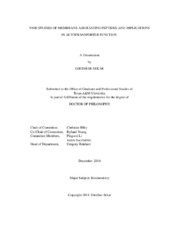| dc.description.abstract | Membrane associating peptides such as antimicrobial peptides and viral fusion peptides are involved in a diverse set of physiological processes. Their functions often require a change in the structure of the peptide, caused by interactions between the peptide and the biological membrane. This change in structure can be investigated in vitro, by performing circular dichroism (CD) and nuclear magnetic resonance (NMR) spectroscopy experiments with peptide solutions in membrane mimetic such as detergent micelles and in organic solvents. NalP is an outer membrane autotransporter protein from N. meningitides that transports its serine protease passenger domain across the outer membrane of the cell. The secondary structure of a linker peptide from this protein was determined in an aqueous medium, in sodium dodecyl sulfate (SDS) detergent micelles and in trifluoroethanol (TFE). The peptide exhibits a random coiled secondary structure in the aqueous medium and has a partial helical character in SDS detergent micelles. In TFE, the peptide has an α-helical secondary structure, and this structure was determined by NMR spectroscopy. The difference in structure of the peptide in the detergent micelle and in the hydrophobic organic solvent, when compared to the aqueous medium, suggests that the linker might interact with the biological membrane during the protein transport event.
The stability of the α-helix formed by this peptide in TFE was determined by investigating the overall and residue specific effects of temperature on the secondary structure of the peptide. Partial loss of secondary structure is observed when the peptide is heated to a temperature of 348 K. Nuclear Overhauser Effect (NOE) crosspeaks that had high relative intensities at elevated temperatures were observed on a stretch of residues located in the middle of the α-helix, suggesting that this region of the α-helix is comparatively more stable and that the unfolding is initiated at both termini of the helix.
The effect of electrostatic interactions on thermally induced unfolding of charged helical peptides was determined in detergent micelles of different charge. In the presence of a similar charge on the peptide and the micelle, the antimicrobial peptide Magainin2 and a mutant of the viral fusion peptide HA G1V showed a greater curvature in the temperature dependence of CD signal at 222 nm, suggesting an increased co-operativity in the helix coil transition of the peptide. The residue specific effects of electrostatic interactions were also determined by measuring the temperature dependence of chemical shifts and NOE intensities of Magainin2 peptide in SDS and dodecylphosphocholine (DPC) detergent micelles. | en |


